Fresh Look: Friendship Skills for Children With ASD Who Use AAC
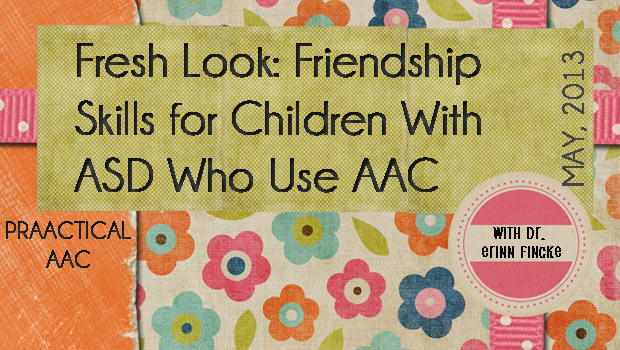
As we’ve said before on this blog, SLPs have great potential to make a difference in the social experiences of people who use AAC by supporting the development of friendships. ASHA’s Better Speech and Hearing Month (#BHSM) gives us a great opportunity to spread awareness that this is an area in which SLPs can make a tremendous difference. We’re so excited to share this Fresh Look post by Dr. Erinn Finke, Assistant Professor of Communication Sciences and Disorders at Penn State University.
I was recently lucky enough to find myself in conversation with Pat Mirenda, a top researcher in the field of AAC and Autism  Spectrum Disorders (ASD). In trying to decide what we really “know” about effective AAC strategies for children with ASD, we decided that while there is a lot of research regarding how to use AAC to teach children with ASD to request things, there really is not too much else. I’m pretty sure we can all agree that children with ASD can be taught to ask for things, but in the words of Janice Light and her colleagues, “There’s more to life than cookies”. This raises an important question; why aren’t we thinking beyond cookies for children with ASD? There are very few researchers focusing on the use of AAC with individuals with ASD. Period. Further, there is a pervasive myth that children with ASD are not interested in social interaction and prefer to be alone in their own worlds, separate from other people. But many of you who have worked with children with ASD know this is not true. In fact, many (if not all) of the children with ASD I have worked with wanted to be liked, have friends and be included in social activities. However, many of them lacked the innate ability to make this desire a reality.
Spectrum Disorders (ASD). In trying to decide what we really “know” about effective AAC strategies for children with ASD, we decided that while there is a lot of research regarding how to use AAC to teach children with ASD to request things, there really is not too much else. I’m pretty sure we can all agree that children with ASD can be taught to ask for things, but in the words of Janice Light and her colleagues, “There’s more to life than cookies”. This raises an important question; why aren’t we thinking beyond cookies for children with ASD? There are very few researchers focusing on the use of AAC with individuals with ASD. Period. Further, there is a pervasive myth that children with ASD are not interested in social interaction and prefer to be alone in their own worlds, separate from other people. But many of you who have worked with children with ASD know this is not true. In fact, many (if not all) of the children with ASD I have worked with wanted to be liked, have friends and be included in social activities. However, many of them lacked the innate ability to make this desire a reality.
What does it take for children with ASD who use AAC to make new friends, and then keep them? Here are five things to think about as you plan intervention to target this very important goal:
1. Children with ASD who use AAC need to be able to interact with other kids. Children learn different things from each other than they learn from adults. This is from participation in their “peer culture”, a culture that we adults are no longer part of.
- This means the child with ASD will need a mode of communication that is effective in highly valued contexts like the lunchroom and on the playground.
- This mode of communication will also need to be set up so barriers to communication with peers are reduced (for example, appropriate vocabulary, iconicity of symbols and intelligibility of the voice output).
2. We can’t force two children to be friends with each other – that’s not how it works. Just because you’ve identified a peer who would be a “perfect” peer model does not mean that child and the child with ASD who uses AAC will become friends. Instead, it may be good practice to choose playmates or “potential friends” based on shared interests and preferred activities.
would be a “perfect” peer model does not mean that child and the child with ASD who uses AAC will become friends. Instead, it may be good practice to choose playmates or “potential friends” based on shared interests and preferred activities.
- Figure out what kids with and without ASD like to do and use that as the context for bringing them together. This may be reading a book, or playing a specific game, even engaging with a mutually preferred video game. Think of activities that kids do when they are at home as well as when they are at school. This will increase the likelihood that budding peer relationships may transfer to play dates and interactions outside of school too.
3. If you want children with ASD who use AAC to have friends and keep them, they need to have specific social skills in their repertoires. They need to know, for example, how to invite someone to play with them; how to ask someone to share with them; how to settle disagreements or perceived injustices; and to handle rejection. This clearly means they need to be able to do more communicatively using their AAC systems than make simple requests.
- These skills will need to be modeled for the child with ASD, including how to use the AAC system to communicate for these purposes. Teachers and clinicians will initially need to clearly mark opportunities to use the target skill in a role-play context. During these role-play interactions, the teacher or clinician will also want to provide natural consequences and respond contingently to the actions of the child. If a social misstep is made, the child with ASD needs to receive honest and authentic feedback. Peers are not going to practice errorless-learning or scaffold the child with ASD. Authentic responses will provide additional learning opportunities.
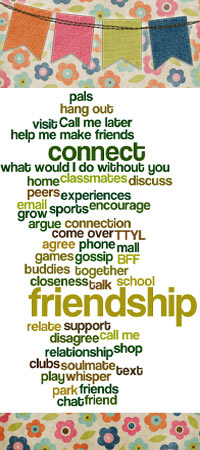
4. Be aware (and I’m sure we all are) that interacting with a child with ASD who uses AAC is a little different than interacting with many other kids in the classroom or neighborhood. This means we will also need to teach the peers some basic interaction skills, and some basic knowledge about the AAC system and how it works.
- We DO NOT want to make the peers into small teachers or tutors, that won’t help us to reach our goal of promoting friendship development. Friendships develop between equals, not between two people with a power differential.
5. We need to ensure the child with ASD who uses AAC has the opportunity to practice their newly learned skills in functional contexts with peers with varying degrees of support. Adult support may be necessary at first, but we eventually want to fade ourselves out. We can’t remain involved at the same level of intensity throughout the course of the children’s friendship – that’s just weird. We want to marginalize our involvement. We want to Teach, Scaffold and Fade, so to speak. We do not want the children with ASD to only use their social skills when we are around.
For further information:
- Anderson, K., Balandin, S., & Clendon, S. (2011). “He cares about me and I care about him.” Children’s experiences of friendship with peers who use AAC. Augmentative and Alternative Communication, 27, 77–90.
- Bauminger, N., Solomon, M., & Rogers, S. J. (2010). Predicting friendship quality in autism spectrum disorders and typical development. Journal of Autism and Developmental Disorders, 40(6), 751-761.
- Borenstein, L. (1996). The development of friendship in childhood: A clinical conversation. Child and Adolescent Social Work Journal, 13(3), 213-224.
- Daniel, L. S. & Billingsley, B. S. (2010). What boys with an autism spectrum disorder say about establishing and maintaining friendships? Focus on Autism and Other Developmental Disabilities, 25(4), 220-229
- Drager, K.D.R., Light, J.E. & Finke, E.H. (2008). Using AAC Technologies to Build Social Interactions with Young Children with Autism Spectrum Disorders. In P. Mirenda & T. Iacono (Eds.) Autism Spectrum Disorders and AAC (pp. 247-278). Baltimore, MD: Paul H. Brookes Publishing Co., Inc.
- Hunt, P., Doering, K., Maier, J. & Mintz, E. (2009). Strategies to support the development of positive social relationships and friendships for students who use AAC. In G. Soto & C. Zangari (Eds.), Practically Speaking: Language, literacy, & academic development for students with AAC needs (pp. 247-264). Baltimore, MD: Paul H. Brookes Publishing Co., Inc.
- Light, J.C., Parsons, A.R., & Drager, K.D.R. (2002). “There’s more to life than cookies”: Developing interactions for social closeness with beginning communicators who require augmentative and alternative communication. In J. Reichle, D. Beukelman, & J. Light (Eds.) Exemplary practices for beginning communicators: Implications for AAC (pp. 187-218). Baltimore, MD: Paul H. Brookes Publishing Co., Inc.
- Wolfberg, P.J. & Schuler, A.L. (1999). Fostering peer interaction, imaginative play and spontaneous language in children with autism. Child Language Teaching and Therapy,15(1), 41-52.
Thanks to PatrickEcker.org for use of the hand-drawn graphics.
Filed under: PrAACtical Thinking
Tagged With: ASD, Erinn Finke, Fresh Look, Friends, friendship, social skills
This post was written by Carole Zangari

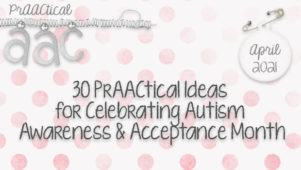
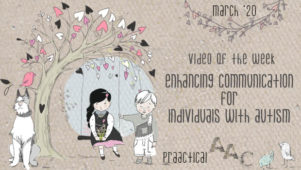
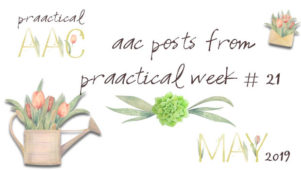
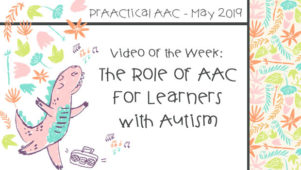
1 Comment
Fellowship resembles a wonderful nursery, the more you put into it, the more it develops.